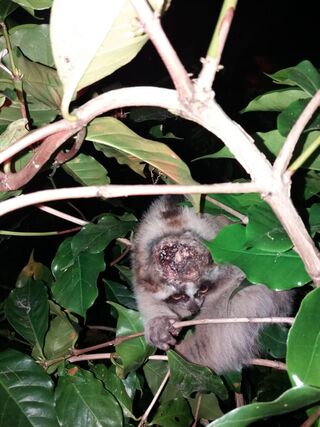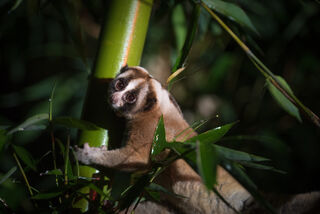Animal Behavior
A Look at an Adorable But Venomous Primate
The slow loris is a rare mammal that packs a venomous bite.
Posted November 9, 2020 Reviewed by Lybi Ma

The slow loris seems adorable. But its puppy-dog eyes and charming face mask belie its wild nature: These primates can be positively pugnacious, defending territories and offspring with venomous — and sometimes fatal — bites.
There are nine species of slow loris, found across Asia from northeast India to the Philippines. All of them are endangered or threatened with extinction. Until recently, scientists knew very little about these elusive, nocturnal animals. Anna Nekaris, a professor in anthropology and primate conservation at Oxford Brookes University, is working to change that. She led the first-ever long-term study of Javan slow lorises, which began in 2011 and involved radio-tracking and following wild individuals. The study is revealing secrets about slow loris lives — starting with their venom.
Venomous Protection
There has been some knowledge that slow lorises were venomous since the 1970s when a medical journal published a report of a human who was bitten and nearly died. Additionally, slow loris bites to other slow lorises are a major cause of death of captive animals.
Their venom is produced by combining oil from an underarm gland with saliva from their mouth. Slow loris bites often result in painful, dramatic wounds, usually affecting the head or extremities. Bitten lorises can lose large patches of fur, injure or lose digits, and incur blindness and nerve damage. Other symptoms include emaciation after wounding, anaphylactic shock, and death — symptoms also reported in human bite victims.

At first, scientists hypothesized that the slow loris’s venom served an anti-predator function. But Nekaris says that slow lorises are so good at hiding that predation does not seem to be a major cause of mortality in the wild. At her team’s field site, there were predators present (eagles and pythons, for instance). But in eight years, the researchers only documented one slow loris taken by a predator.
Another hypothesis was that slow lorises could use their venom to capture prey. Although they primarily feed on tree gum, lorises occasionally eat insects and small animals. But when Nekaris and her colleagues looked at how the primates subdue these meals, they found lorises just bite their prey’s head off, no matter its size.
“They don’t need venom to subdue prey because they already have powerful teeth,” says Nekaris.
Next, Nekaris and her colleagues tested a potential anti-parasite function of the venom. Nekaris says that when they capture lorises, the animals are remarkably free of external parasites like ticks and fleas. And indeed, when the researchers applied venom to an array of parasites, they died within 30 seconds to one minute.
Loris versus Loris
Although it appears slow loris venom plays a role in protection from parasites, animal venoms often have multiple functions. And the picture Nekaris and her team were getting from their field observations appeared to support another use for the venom.
“Over the course of the eight years of our study, the thing that astounded us was the number of damaged individuals fighting each other,” says Nekaris. “They had horrendous wounds from fighting with each other. We witnessed one animal killed through a venomous fight.”
Nekaris and her colleagues reported that 33 percent of females and 57 percent of males exhibited at least one head wound characteristic of a bite from another loris.
The researchers found that slow lorises are highly territorial. Adult males defend territories with prized gum trees, as well as mates, from intruders. Adult females defend their offspring, which can spend as many as three years with their parents before dispersing to find a new territory. And young lorises might have it the hardest. They often have difficulty when leaving home and settling into new territory. It’s a time when lorises frequently get into fights with other lorises.
While using venom to fight with other members of one’s own species might seem bizarre, slow lorises are not alone. The platypus is another venomous, territorial mammal that uses venom in disputes with its own kind (although only male platypuses are venomous).
“Although it is rare to use venom for intraspecific competition, it is common to have a weapon,” says Nekaris. “There are plenty of animals that have exaggerated tusks, horns, or other features that act as weapons in intraspecific fights.”
Warning Signs
According to Nekaris, slow lorises aren’t trying to keep their venom a secret. In fact, they may be advertising their toxicity with their markings.

To Nekaris and her colleagues, the conspicuously colored face masks adorning slow lorises looked like a classic example of aposematism: a warning signal to emphasize an animal’s unpalatability or toxicity (think of a skunk’s contrasting stripes).
When Nekaris analyzed photos of slow loris face masks, she found that younger animals had more contrasting facial markings than adults. These juvenile animals were also the most aggressive, “fiercely attacking measurers when handled and often growling or even shrieking.”
“The period when their markings are most contrasting is the same time at which they are dispersing and trying to find a new home range,” she says. “This is a time when they are potentially more dangerous to other lorises.”
Nekaris and her colleagues say that striking facial patterns may be a way to communicate to other slow lorises, indicating the aggressiveness of young animals looking to settle into a new home range.
It’s not known whether these younger, dispersing animals differ from adults in toxicity as well as aggression. Nekaris says there is still a lot to learn about how slow loris venom works. For instance, she would like to know why these venomous bites seem to be more lethal in captivity than in the wild. It’s possible that venom potency or healing ability is affected by diet and captive animals are missing out on key foods, but no one really knows.

Slow Lorises Belong in the Wild
Nekaris says that one upside of her research is that making people aware of this deadly venom helps with the conservation of lorises. In addition to facing habitat loss and the traditional medicine trade, lorises are very desired for the illegal pet trade.
“Slow lorises look so cute,” Nekaris says. “People don’t see them as wild animals anymore. Maybe the only slow lorises they’ve seen have been in viral videos.”
But these seemingly cute videos don’t tell the whole story of slow lorises’ plight in captivity. First, lorises are protected everywhere they are found and all commercial trade of the animals is banned. It is simply illegal to own a slow loris as a pet.
Second, illegal wildlife traders cut out slow loris’s teeth — both to prevent them from biting and killing each other during transport and so they cannot bite and severely injure their owners. Nekaris says it is a horrendous practice that can result in painful and lethal abscesses.
Finally, slow lorises are very specialized animals that are just not suitable as pets. They are nocturnal and their eyes can be injured through overexposure to bright lights. Their peculiar diet of mainly tree gum is hard to replicate in captivity, even in zoos. Animals kept as pets and fed inappropriate diets of rice and fruit develop kidney disease, diabetes, and tooth infections that can lead to death.
“They are endangered in the wild,” Nekaris says. “There is no reason to have these animals as pets. There are plenty of other cute animals that have been domesticated that make much more suitable pets than slow lorises.
“And their bite can kill you.”
References
Nekaris, K.A.I., Campera, M., Nijman, V., Birot, H., Rode-Margono, E.J., Fry, B.G., Weldon, A., Wirdateti, W., and Imron, M.A. (2020). Slow lorises use venom as a weapon in intraspecific competition. Current Biology 30(20): PR1252-R1253. Doi: 10.1016/j.cub.2020.08.084.
Nekaris, K. A., Weldon, A., Imron, M. A., Maynard, K. Q., Nijman, V., Poindexter, S. A., & Morcatty, T. Q. (2019). Venom in Furs: Facial Masks as Aposematic Signals in a Venomous Mammal. Toxins, 11(2), 93. Doi: 10.10390/toxins11020093.




